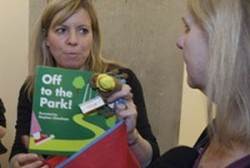Learning Through Touch
Published on: 06 January 2015 Author: Alex Strick
This week saw World Braille Day. So who reads Braille? By no means all blind people. In fact, not even one per cent of the two million visually impaired people in the UK - so as few as 20,000 people. Most Braille readers are over 65 and likely to have been blind from a very early age. And sadly it is a number which is in decline.

Yet the benefits to learning the system remain extensive - even in this hi-tech age. And whether or not children go on to learn Braille, early tactile experience is crucial. Both for children who are blind and those who have some sight, early exposure to a vast range of tactile experiences is key. Indeed, offering tactile books is of course valuable and exciting way to support any child's exploration of the world.
Jeri Cleveland and Debra Sewell describe early tactile experience as a 'pathway to progress.' They say:
'Visual impairment affects the whole process of information gathering. Far too often we expect blind or visually impaired children to base their knowledge of the world on verbal descriptions and very limited "'hands-on" experiences. This cannot compare to the almost constant kaleidoscope of incidental information that fully sighted children have taken in before they go to school.'
Tactile books have a valuable role to play in terms of supplying some of these many tactile experiences visually impaired children need. So it's crucial that such books offer really varied textures, shapes and concepts. Too often such books can be rather repetitive with one tactile element difficult to distinguish from the next. It's also vital that the objects in the book are meaningful and recognisable to the audience.
This is where Off to the Park!, the book created for Booktouch by Child's Play and Book Trust was so successful. Careful research ensured that the objects selected were readily recognisable by touch.
Another of the ways in which books like Off to the Park! are particularly effective is by supplying simple, bold, contrasting images and avoiding any unnecessary 'clutter' whether visual or tactile. As tactile book experts ClearVision explain on their website, really successful tactile books are simple but effective, eliminating anything which isn't directly relevant.
Let's hope 2015 sees more really effective touch and feel books start to appear on the children's book landscape.
Topics: Bookmark, Disability, Visual impairment, Features






Add a comment